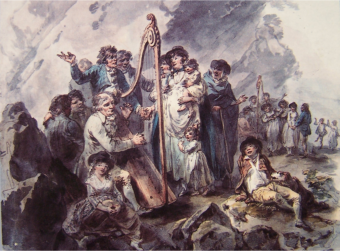Cerdd Dant on:
[Wikipedia]
[Google]
[Amazon]
 ' (, or ') is the art of vocal improvisation over a given
' (, or ') is the art of vocal improvisation over a given
 ' (, or ') is the art of vocal improvisation over a given
' (, or ') is the art of vocal improvisation over a given melody
A melody (from Greek μελῳδία, ''melōidía'', "singing, chanting"), also tune, voice or line, is a linear succession of musical tones that the listener perceives as a single entity. In its most literal sense, a melody is a combina ...
in Welsh
Welsh may refer to:
Related to Wales
* Welsh, referring or related to Wales
* Welsh language, a Brittonic Celtic language spoken in Wales
* Welsh people
People
* Welsh (surname)
* Sometimes used as a synonym for the ancient Britons (Celtic peopl ...
music
Music is generally defined as the art of arranging sound to create some combination of form, harmony, melody, rhythm or otherwise expressive content. Exact definitions of music vary considerably around the world, though it is an aspe ...
al tradition. It is an important competition in . The singer or (small) choir
A choir ( ; also known as a chorale or chorus) is a musical ensemble of singers. Choral music, in turn, is the music written specifically for such an ensemble to perform. Choirs may perform music from the classical music repertoire, which sp ...
sings a counter melody over a harp
The harp is a stringed musical instrument that has a number of individual strings running at an angle to its soundboard; the strings are plucked with the fingers. Harps can be made and played in various ways, standing or sitting, and in orc ...
melody.
History
is a unique tradition of singing lyrics over a harp melody. Traditional singers who sang in stately homes tended to sing in a Welsh language that had strict rules about metre, rhyme, and acceleration. is usually performed by a solo singer and a harpist; however, it is also performed by choirs and with several harps. A common form is have a harp melody written down or a well known tune, while the vocalist improvises their own harmony while singing a poem. When sung in a competition, there are strict rules about rhythm and cadences. When finishing a piece, the final verse has to end on a perfect cadence that is close to the home key so that the ending of the song is clear. In Wales, during the 14th, 15th and 16th centuries, two arts flourished side by side: ' (the craft of the tongue, poetical craft) and ' (the craft of string music). The poets and musicians were part of an all-embracing bardic system. The poets wrote verse of an occasional nature, praising the exploits and virtues of their patrons: the Welsh nobility and high-ranking clergy. They also provided elegies, devotional poetry, commemorated the generous acts of their patrons and satirised certain people in verses which might have the intensity of curses. The art of poetry was learnt orally, i.e. examples were learnt by heart and exercises given as spoken instruction. Part of the poet or musician's craft was the ability to remember the important work of previous generations. One of the spurs to the active and generous patronage of poets must have been the prospect that one's name and deeds would live forever. In descending social order came: poet, harper, player and the specialised singer of bardic verse, the '. The crafts of poetry and instrumental music were interdependent and the performance of a new poem, at its most splendid, probably required the services of the ', harpist and/or ' player; no doubt superintended by the poet. Between the beginning of the 14th century and the end of the 16th century Welsh poetical forms were brought to an extreme pitch of elaboration.Popularity
is still an important part of Welsh culture and is continued to the present day. It is a major element of theNational Eisteddfod
The National Eisteddfod of Wales (Welsh: ') is the largest of several eisteddfodau that are held annually, mostly in Wales. Its eight days of competitions and performances are considered the largest music and poetry festival in Europe. Competitor ...
and an annual festival celebrating is held each year.
Notes
{{Authority control Medieval music genres 16th-century music genres Welsh-language music Welsh styles of music